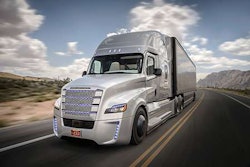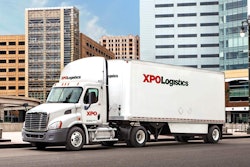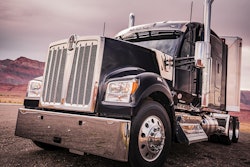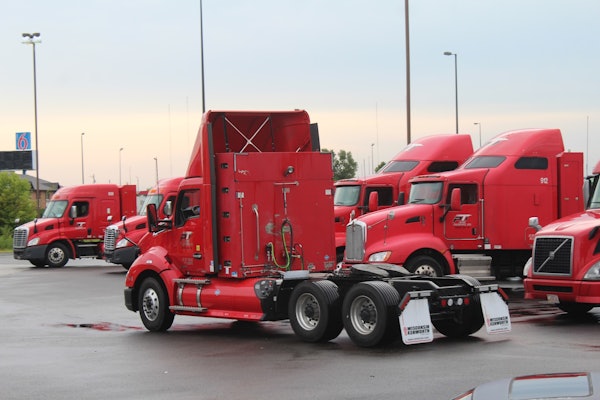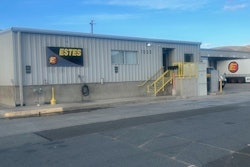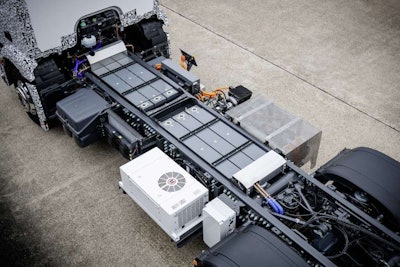
Elektromobilität; modulares Batteriekonzept; Verteilerverkehr ; Mercedes-Benz Trucks; Urban eTruck; Electro-Lkw; world premiere; electric mobility; modular battery concept; distribution;
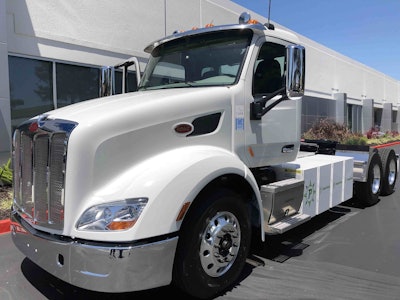 The fully electric Model 579 demonstration unit is equipped with eight 44-kW battery packs and has a range of up to 250 miles.
The fully electric Model 579 demonstration unit is equipped with eight 44-kW battery packs and has a range of up to 250 miles.Discussion around new trucking technologies like electrification and autonomy is usually water cooler fodder for the purchasing department, but if it’s going to hit the highway it’s eventually going to need service.
These cutting-edge trucks will come with maintenance needs and methods unlike anything even the most tenured shop foreman has seen, especially when it comes to the needs of complex radar and camera systems used for autonomous driving.
“This will be new training for maintenance folks,” says Chuck Price, vice president of product for TuSimple – a San Diego-based autonomous truck startup that is already logging Level 4 autonomous miles. “The actual work will be very compatible with what folks are doing today … it’s different but it’s still replacing components, aligning components [and] getting readouts from the diagnostics port. We’re trying to make it compatible with how maintenance teams operate today.”
Electric trucks, with levels of voltage generally left to electricians, pose a different kind of challenge.
“You don’t have the opportunity to electrocute yourself on a diesel vehicle the way you do with an electric vehicle,” says Chris Nordh, Ryder System’s senior director of advanced vehicle technology and energy products for its fleet management solutions segment.
A person can be fatally electrocuted by as little as 42 volts and electric vehicles use several hundred direct-current volts to operate, making safety a top maintenance priority.
On the battery pack, there is a high-voltage switch that can turned off and locked-out – the equivalent of the truck’s breaker box – making working on the system safer.
“Now you’ve de-electrified the entire system,” Nordh says. “The only place that has high-voltage is now inside the battery pack itself … and you never, ever, ever break into the battery pack. You don’t open it. You don’t take a screw out of it. That’s one of those untouchable kind of things.”
The truck’s 12 or 24 volt systems are still active, but most technicians should be accustomed to working with low voltage.
Price says there will be a variety of new sensors installed on automated vehicles, including cameras, radars, ultrasonic sensors and LiDAR, and each of those will need to clear field of view to facilitate autonomy.
“Camera systems require good optics. They require that the optical path is clean,” he says, “and that means that we have a cleaning system that is part of the optical system, which includes mechanisms for automatically cleaning the glass that’s in front of the lenses.”
For truck techs that will mean they are responsible for the basic maintenance of both the camera system and its cleaning system, which Price says could include topping off fluids.
Computer-based diagnostic platforms were revolutionary a generation ago but are now commonplace. The next generation of diagnostics, those that Nordh says support electric trucks, will be on a completely different level.
“Now you’re talking about a piece of equipment that is way more advanced, way more automated than an internal combustion engine,” he says, “so your diagnostics change pretty drastically.”
The plug in and download process, Nordh says, should be familiar as will the fault tree. What will cause the disruption is that these vehicles and many of their components won’t be made by the same manufacturer.
“Most electric vehicles aren’t from necessarily traditional OEMs, whether it be an upfit or a pure [electric vehicle] from the ground up,” he says, noting Ryder started looking at electric trucks nearly three years ago. “So now you have to get ahold of their software and their connector tools and potentially another computer if you need new hardware in order to hook up to it.”
With so many manufacturers playing a role under the hood and along the chassis, Nordh says the most difficult part could be getting your hands on the truck’s maintenance manual.
The manuals will need to be aggregated because there’s so many components brought in from so many manufacturers, but Nordh says “it’s really the OEM’s responsibility to put together a manual that holistically looks at all those pieces together – how they interact with each other – and create a single point where you’re connecting to the vehicle in order to get all these fault codes that may be spat out of the vehicle.”
“We’ve actually seen electric vehicles with four different places to connect to in order to get a true diagnosis done on a vehicle,” he adds. “When you look at it from an efficiency perspective, that does not work.”
Nordh says Ryder’s maintenance department reviews and comments on a truck’s service manual before the company ever decides to place an order “to make sure that everything that they normally need to do or need to know about a vehicle is in there.”
A truck chassis is a vibration and shock-rich environment. Price says autonomous driving cameras are precision-aligned at the factory but will need to be periodically recalibrated and realigned as they are bounced and jarred along their routes.
Price says his company plans to offer calibration services and maintenance but also expect to offer training at the fleet-level.
“This kind of maintenance in some ways would be similar what’s done by a mechanic today. They’re looking at fault codes and they’re going into equipment maintenance manuals and seeing what the proper response steps are for those particular faults,” he says. “For some items it might be to return the camera and get a replacement, and in others they’re might be certain alignment steps to follow.”
The technician will have a support system in place that includes the truck itself, which Price says will be able to self-diagnose many issues.
“The system can detect when a camera needs recalibration,” he says. “Typically, the way this will work – because our system can detect when there are faults – is we will receive an active notification live. It could be a case where a local maintenance individual would also revive that fault. We have to know at all times the health of all the components that comprise the safety systems of the vehicle. The vehicle itself will self-diagnose constantly.”
In current driver-assist technology, the driver would ultimately be in control of the truck in the event of any failure or fault.
However, once the driver has been removed completely – Level 5 autonomy – the system will have to serve as its own failsafe.
“All of our sensors have corroborating sensors that allow us to tell us if a particular sensor is drifting or failing,” Price says, “and we must be able to respond without moving into an unsafe state.”
Price says autonomous technologies have to anticipate all possible failure modes and develop an action plan that “allows the system to move to a maximum safe condition in the face of failure,” he adds. “That safe condition may be as significant as moving the truck off the road.”
While the technologies themselves may be overwhelming, the process of maintaining them, Price says, is much simpler. Generally, he says, technicians will only be required to keep the sensors clean and replace any that fail.
“A lot of the sensors, at their mount points, are straightforward items. They are units that are bolted or clamped or fastened in a secure way and that’s pretty straightforward,” he says. “They have to locked down because they’re on a vibrating platform, but they will be accessible using tools mechanics use today.”
A study released last month from the U.C. Berkley Center for Labor Research and Education says autonomous trucking technology could eliminate nearly 300,000 driving jobs, with the greatest impact landing across segments that historically have offered drivers the best wages.
“Specifically, self-driving trucks will be best suited for use in industry segments with long stretches of highway driving, minimal need for drivers to perform other tasks, and large firms with the capital to buy (and expertise to integrate) new technologies,” says the report authored by University of Pennsylvania Sociologist Steve Viscelli. “These are some of the best jobs in the industry, and drivers earn some of the highest incomes in trucking, in part because of high unionization rates.”
Viscelli, forecasts “significant job loss” in less-than-truckload and parcel segments, where average driver pay rates range from about $60,000 to nearly $70,000 annually. Upwards of 50,000 less-than-truckload and 30,000 parcel driving jobs could be absorbed.
Even if there’s no driver in the vehicle, Price says there will still be a manual pre-trip and post-trip inspection that’s done by humans, and that most likely will now become a function of the maintenance department.
“The sensor suite will become part of a physical inspection check,” he says. “The typical pattern will [include] a pre-trip to include a physical evaluation of the sensors along with the rest of the truck.”
While adding more things for the repair bay to maintain sounds like added work, Price says autonomy could actually lead to a lower mechanical workload because the trucks operate “more gently autonomously than with a human driver,” he says. “We’re operating the system to the best of the manufacturer’s recommendation for the longevity of the vehicle and for sustainability. We’re trying to consume the minimum amount of fuel and, if possible, we’re putting less stress on the engine.”
While maintenance on electric trucks will almost certainly be less costly – a byproduct of fewer moving parts – Bendix Director of Customer Solutions – Controls, Fred Andersky cautions fleets running toward technologies like electrification and autonomy as a cost cutting solution to look at the bigger picture.
“When customers went to CNG/LNG, they had to change their entire maintenance facility. They had to have a combustion-proof facility,” he says. “There’s going to be other costs that are going to come into play with these vehicles.”
However, since a machine offers greater precision and fine control than a person, Price expects to see reduced component wear.
“It’s things like that that are sort of interesting things that the maintenance team can start to appreciate,” he says. “So their maintenance schedules may change in interesting ways.”




